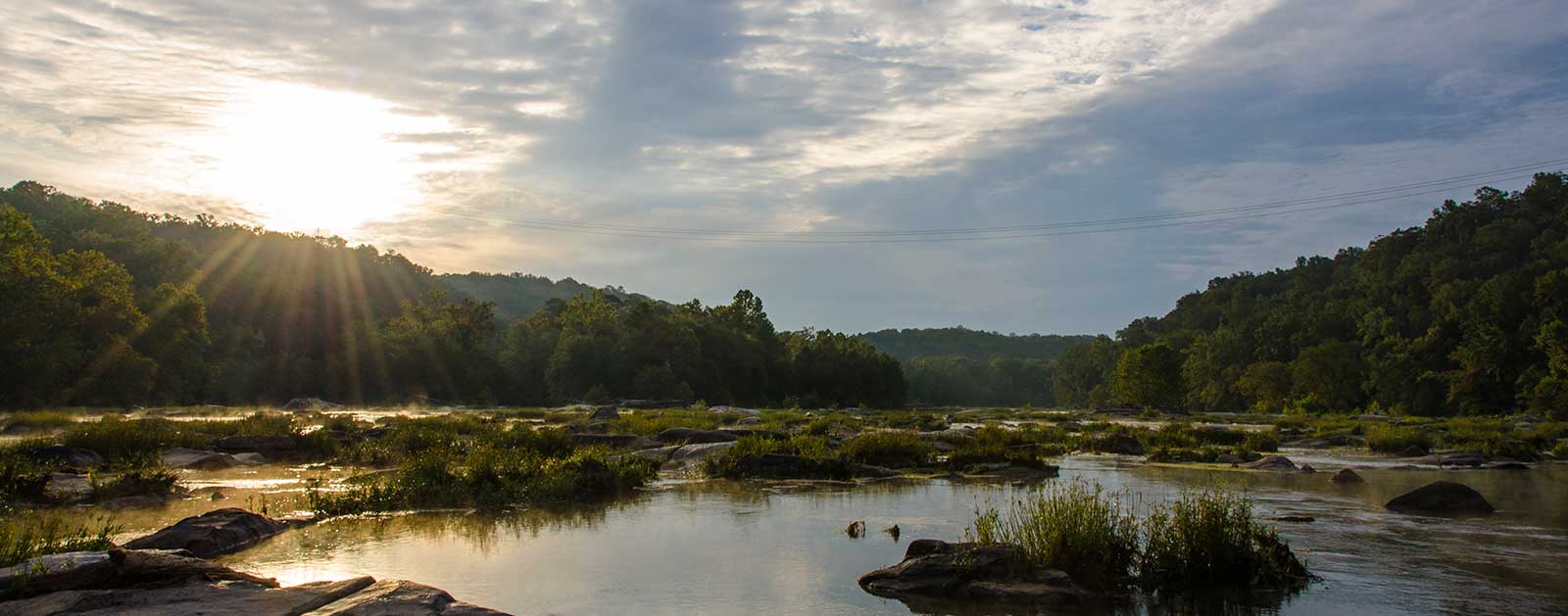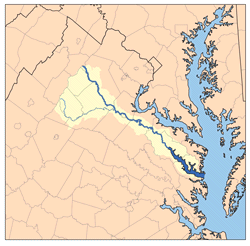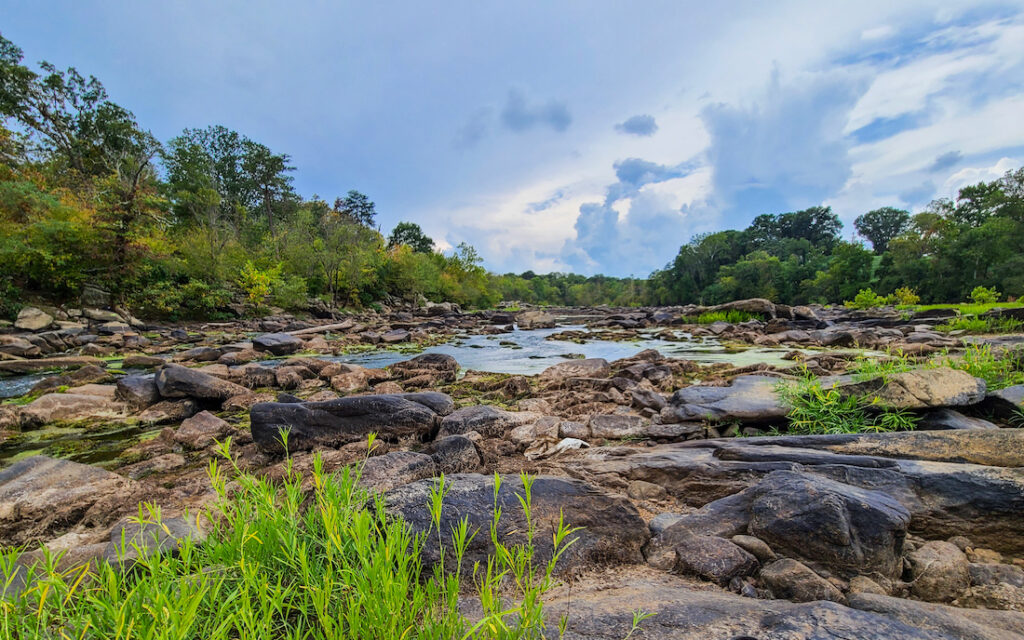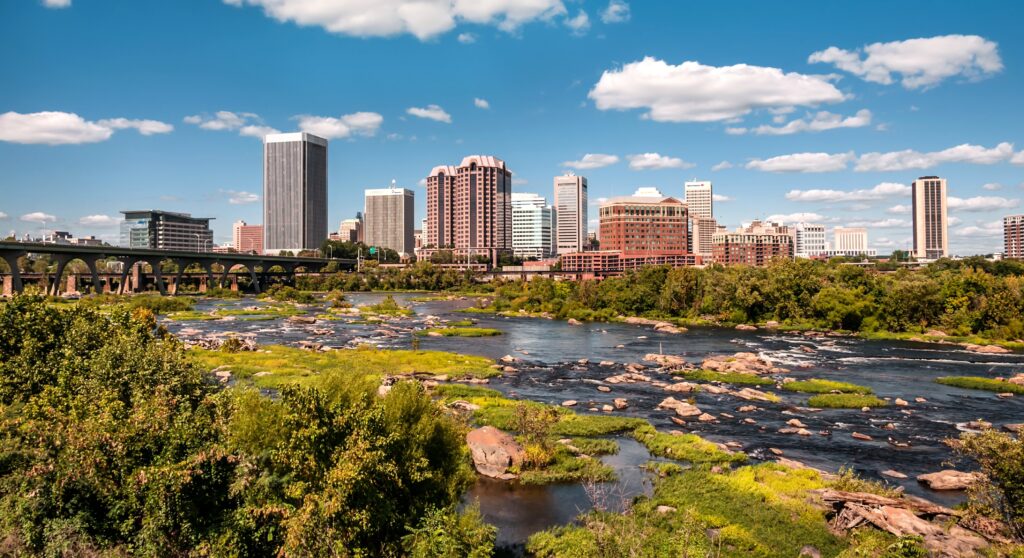Rappahannock River
Fish On

The love of fishing knows no bounds. Certainly not on the Rappahannock River, at least, where Virginia Senator John Warner’s passion for fishing his home rivers provided the final push needed to reconnect the 195-mile river from the Blue Ridge Mountains across the Piedmont to the Chesapeake Bay, establishing the longest free-flowing river in the East.
The mutual love of fishing brought Sen. Warner in contact with the Friends of the Rappahannock’s John Tippett, igniting an 8-year effort to remove the 22-foot-high Embrey Dam in Fredericksburg and free the river from its confines for the first time in 150 years. Breaching the outdated dam in 2004—thanks to federal funding secured by Warner—restored the free-flowing river, improved paddling and angling opportunities, and improved habitat for migratory fish. Hickory shad, striped bass and blueback herring can now travel some 170 miles from Fredericksburg up into the Blue Ridge Mountains.
There the fish join robust populations of smallmouth bass and redbreast sunfish to provide excellent angling above tidal influence. About 24,000 angler visits are tallied annually above Fredericksburg and the former Embrey Dam site. Species composition shifts with habitat, and largemouth bass, catfish, and anadromous species are more common in and below Fredericksburg.
The Rappahannock’s upper reaches, from the headwaters to Mayfield Bridge in Fredericksburg, are designated State Scenic River. In addition to being one of Virginia’s top destinations for smallmouth bass angling, the picturesque waterway offers outstanding canoeing and camping along an almost completely unspoiled historical river corridor. Brimming with Civil War history, the Rappahannock is considered one of the most scenic and best-protected river corridors in the Chesapeake Bay watershed. The Rapidan River, originating from the west side of the state, connects with the Rappahannock about 10 miles northwest of Fredericksburg, providing additional spawning habitat for migrating fish since the dam breach.
Did You know?
Since the 2004 breach of the Embrey Dam, the Rappahannock River is the longest free-flowing river in the Chesapeake Bay watershed and the eastern U.S.
During Colonial days, the Rappahannock River was a major shipping artery for transporting tobacco, salted fish, iron ore, and grains.
The estuary of the Rappahannock River is renowned for growing the least salty oysters on the East Coast, famous for their sweet and smooth flavor.
What states does the river cross?
Virginia

America’s Most Endangered Rivers®
The Rappahannock River was named as one of America’s Most Endangered Rivers® of 2025. The Rappahannock River is one of Virginia’s most iconic waterways, stretching over 195 miles from the Blue Ridge Mountains to the Chesapeake Bay. The river supports a diverse array of ecosystems and provides critical habitat for fish and wildlife. However, increased strain on water resources and the absence of unified water management threaten the river’s ability to meet the needs of both people and nature. As the region continues to grow, protecting the Rappahannock’s health and sustainability is more important than ever.

Protect the Rappahannock River
Tell Virginia decision-makers to ensure a strong and healthy future for the Rappahannock River by implementing smart, science-based water management solutions.
The Backstory
Some historians believe the Rappahannock served as a possible boundary between the North and the South during the Civil War. Certainly it was the site of early settlements in the Virginia Colony and of some major battles during the Civil War. The Battle of Fredericksburg and the Battle at Rappahannock Station both took place along the river in 1862.
Embrey Dam was constructed in 1910, replacing a crib dam dating back to 1853. The dam at one time provided water to a Virginia Electric Power Company power station and supplied drinking water for the city of Fredericksburg by way of a historic navigational canal. With the dam in place, the Rappahannock River was impassible above Fredericksburg to anadromous fish during their annual voyage from the Chesapeake Bay, causing many miles of potential spawning habitat to be lost.
The river once had great local significance as a port-of-entry, but gradually became less of a source of transportation and more of a source of recreation and beauty. The river remains a primary source of the growing region’s water supply.
American Rivers named the Rappahannock one of America’s Most Endangered Rivers® of 2017 due to the threat proposed hydraulic fracturing — fracking — for natural gas posed to the river’s clean water. American Rivers’ partners leveraged the report to encourage local municipalities to enact their own restrictions on fracking and improved statewide standards for fracking, including full disclosure of the chemicals pumped underground during drilling. In April 2020, Virginia Gov. Ralph Northam signed a bill into law banning fracking east of Interstate-95, protecting the drinking water supply for a large portion of the Commonwealth of Virginia.

Let's Stay in touch!
We’re hard at work in the Mid-Atlantic for rivers and clean water. Sign up to get the most important news affecting your water and rivers delivered right to your inbox.
The Future
Today, much of the river’s watershed is rural and forested but is facing increasing pressure from development and population growth. The relatively recent increase in development in the south suburbs of Washington D.C. is changing the appearance of the area and the local impact on the river.
American Rivers’ current focus is on reaching out to dam owners about removing unwanted barriers on Rappahannock River tributaries. The scope of that work will be more fully formulated following the completion of our strategic plan for the Chesapeake Basin.
